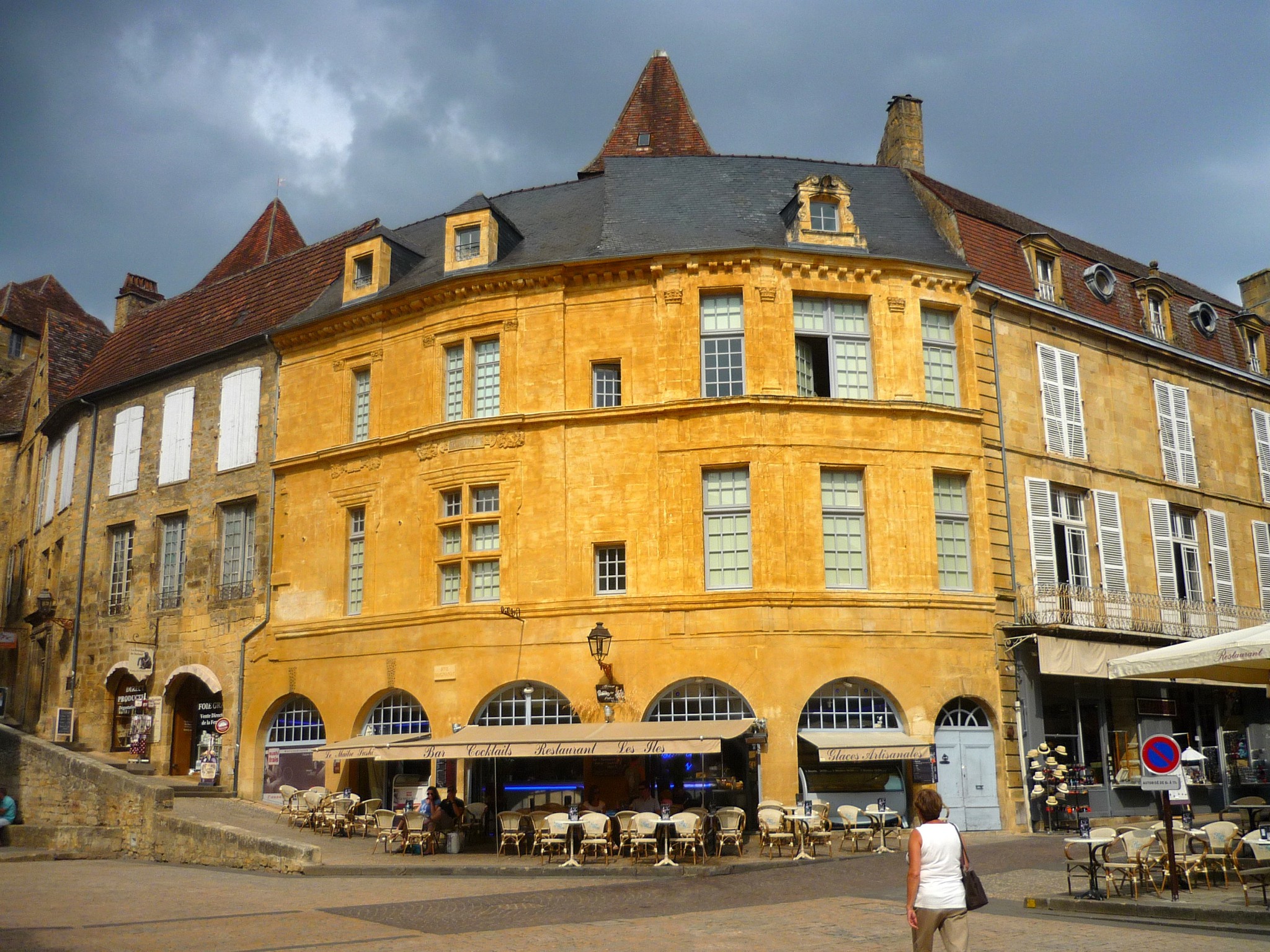Sarlat Old Town is divided in two by the Rue de la République, known as “la Traverse”. The district to the West of the street is known to be more ‘common’, while the eastern side is more aristocratic.
The Tourist Office is located to the South, next to the Cathedral St. Sacerdos and a few metres away from the Place de la Grande Rigaudie. The famous Place de la Liberté and the aristocratic Rue des Consuls, with its beautiful mansions, are towards the northern part of town. Below are details of some of Sarlat’s most famous monuments but, when visiting the town, be sure to let yourself be surprised by discovering the little arched passages and lanes along the way as well…
Situation Map of Sarlat
The old town of Sarlat and its main sights:
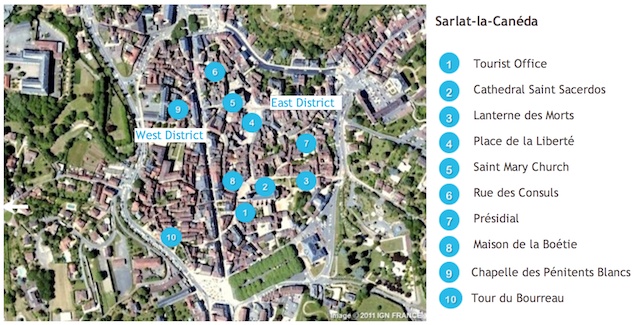
The district around the St Sacerdos Cathedral:

The Episcopal Palace (Palais Épiscopal)
The Episcopal Palace (or former Bishop’s Palace) stands to the right of the Cathedral’s porch. The building was reconstructed by Bishop Nicolo Gaddi, defender of Machiavelli, “rival” of La Boëtie. The façade of the Episcopal Palace is adorned with sculptures of men’s heads, monsters and Atlantes, and shows the influence of the Italian Renaissance in Sarlat. The first and second floors are in the Gothic style, while the third floor contains an interesting loggia added by Gaddi, isolated by an corner-turret. This house is now host to Sarlat’s Tourist Office.
Cathedral St. Sacerdos
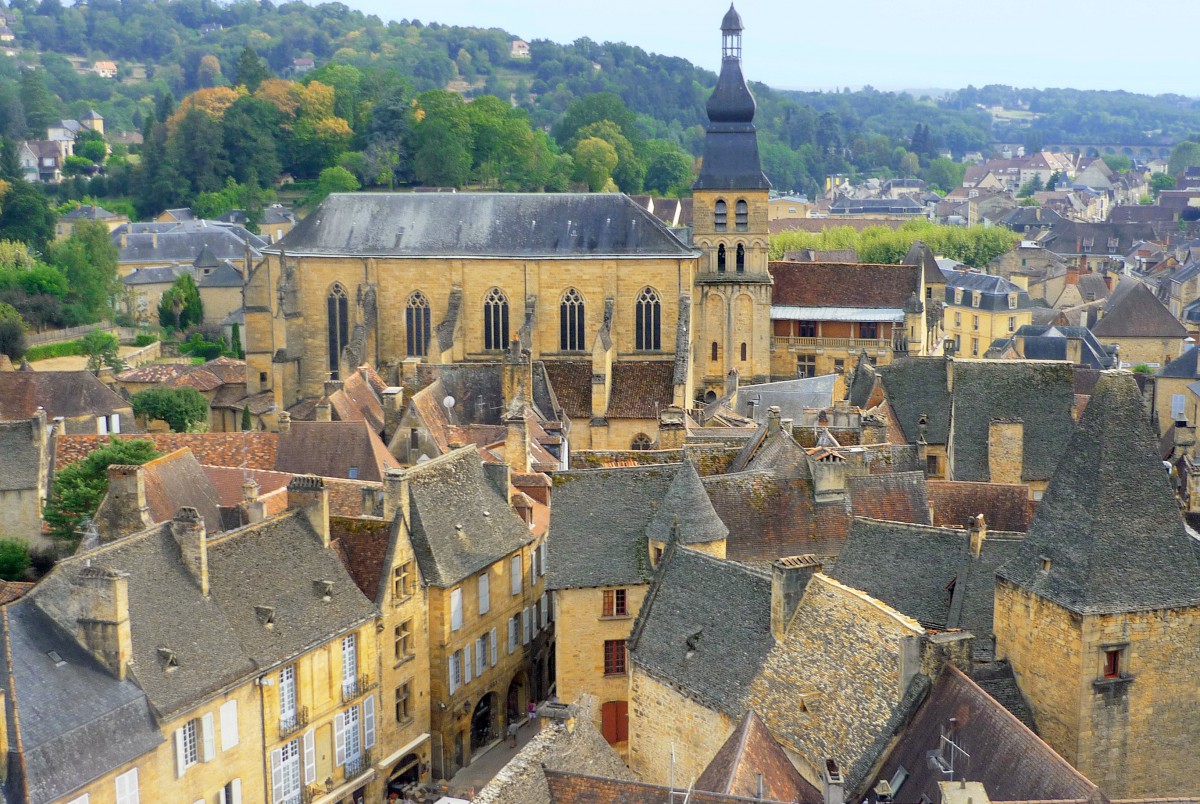
Located on Place du Peyrou, this church was originally part of a Benedictine Abbey, which dated to the 12th century, but has been rebuilt in a predominately Gothic style since the 16th century. This explains the distinct lack of architectural unity, as the main Gothic style structure has been built between the apse and the bell-tower.
The base of the bell-tower, an elaborated turreted tower from the 12th century, is the oldest part of the church. It contains groin-vaulted ceilings, Carolingian faces and is topped by a bulbous roof. The large entrance was added in the 17th century, above which visitors can see five statues of unknown origin and date.
The interior has interesting panelling, statues and tombstones from the 17th century, an altar (16-17th centuries) and an organ built by J.-F. Lépine, a renowned organ maker.
When leaving the Church by the southern left-hand side-door, you come to the old abbey cloister (cour du cloître) and three broken arches, which are all that remains of the ancient Romanesque cloister.
Nearby stands the little chapel of the Pénitents Bleus (or Chapel Saint Benoit) whose interior is remarkable for its pure Romanesque style, and the Canon Courtyard (Cour des Chanoines), and Fountains Courtyard (Cour des Fontaines), where one of the two fountains that were used by the Abbey still runs freely.
Walk across the peaceful Cour des Chanoines.
The Cour des Fontaines is bordered with cafés and crêperies:
The little arched passage behind the chapel leads to the Jardin des Enfeus through a little courtyard where recitals and play are given in the summer.
The Jardin des Enfeus
The sloping garden behind the cathedral contains tombstones from the monastic cemetery. Arched insets (called ‘enfeux’ in French) cover the tombs which used to contain the sarcophagi of the distinguished gentry of Sarlat from the period between the 14th and 16th centuries. One of them is adorned with sculptures from the 16th century and covers the body of a young maid, Anne de Dautrerie, who died from the Plague.
Behind the garden stands a strange, conical tower known as the ‘Lanterne des Morts’ (Lantern of the Dead) or St Bernard’s Tower, which was built in the 12th century.
Its origins and actual function are unknown and consequently give the monument a rather mysterious aura. For some, the Lantern commemorated the passage of Saint-Bernard de Clairvaux to Sarlat in 1147, while preaching against Catharism. The Saint was said to have blessed bread, which miraculously cured the sick at the Calvary of Roc Laumier at La Canéda. The Lantern consists of two rooms, though the upper room is strangely inaccessible to people.
Today, this ancient cemetery is a peaceful, charming place, often animated in summer thanks to concerts and cultural events. There is a fine view over the chevet of St. Sacerdos Cathedral.
Don’t miss the picturesque Rue Montaigne with houses from the Renaissance era when coming down to Place du Peyrou.
The Boëtie Mansion (Maison de la Boëtie)
The Boëtie Mansion, facing the Cathedral, is one of the symbols of Sarlat. It was built in 1525, in Italian Renaissance style, by Antoine de la Boëtie. His son Etienne, was born there in 1530 and became a famous French writer, and friend of Montaigne.
The façade of the building displays large mullioned windows framed by pilasters, carved with medallions and diamond shapes. The old roof, tiled with ‘lauzes’ (flat limestone, typical of Périgord), is outlined by sculpted pinnacles depicting cabbages and sheep. The house also borders the Passage Henri-de-Ségogne, an attractive, narrow, medieval street typical of Sarlat. The inside of the mansion hosts a painting exhibition.
On the ground floor, follow the picturesque Passage Henri-de-Ségogne which leads to the Vienne Mansion through a series of half-timbered houses and wooden corbels. The place is busy in the summer with a wide range of restaurants offering local dishes.
The Vienne Mansion (Hôtel de Vienne or de Maleville)
The Vienne Mansion (or Maleville Mansion) is located in a corner of the Place de la Liberté. This old house, which looks like a small castle, belonged simultaneously to Jean de Vienne, superintendent of finances to King Henri IV, and to the descendants of jurist Jacques de Maleville, who contributed to the writing of the Napoleonic Code.
This house actually consists of three adjoining houses of different architectural styles, which were joined together.
This display of Gothic, Italian and French Renaissance elements is underlined through the presence of mullioned windows, renaissance windows (on the façade bordering Place de la Liberté) and corbelled turrets. The squared staircase tower features a Renaissance portal, whose pediment displays medallions depicting Henri IV and Gabrielle d’Estrées.
Place de la Liberté and the former Sainte Marie Church
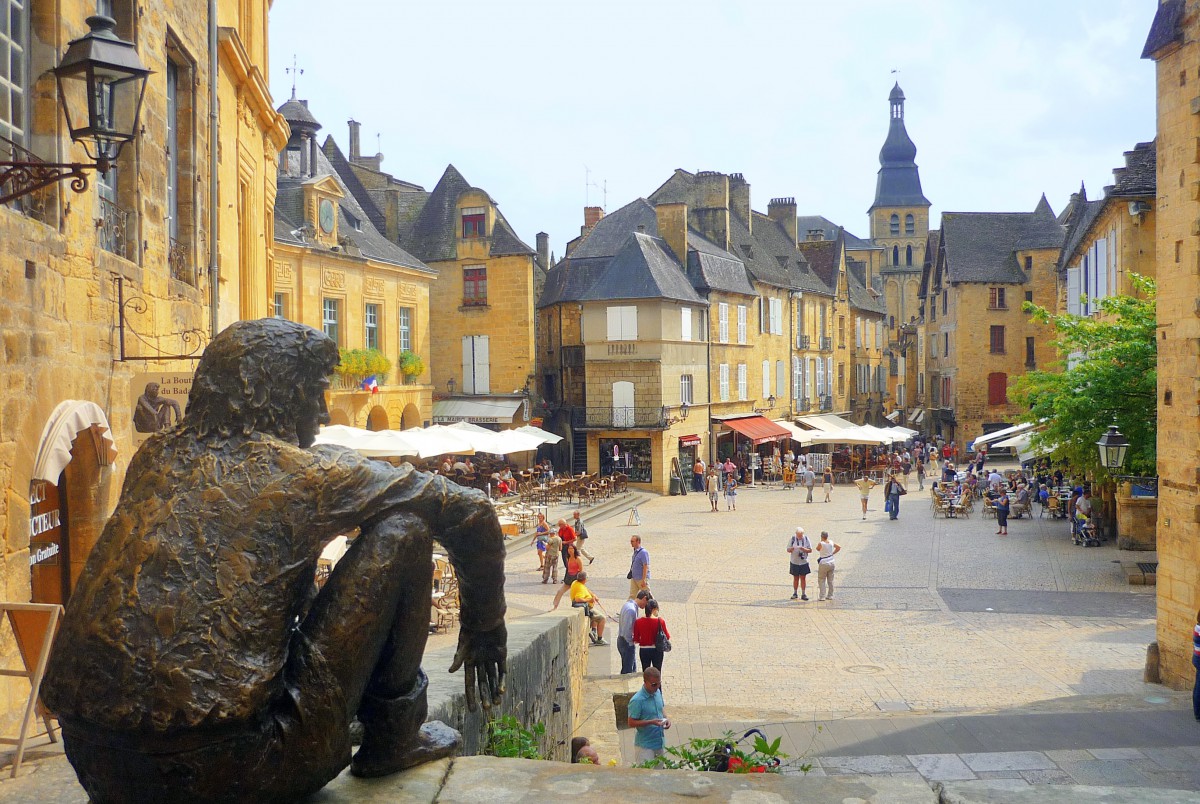
The main square of the historic town of Sarlat is fringed by outdoor cafés, the 17th century town-hall and the former church Sainte-Marie, recently converted into a covered market place.
Built between 1365 and 1479, the church Sainte-Marie was a symbol of the success of the ‘bourgeois’.
The former parish church of meridian Gothic style was amongst the many national buildings damaged and sold during the French Revolution (and was entirely in disuse by 1794). All that remains today are two bays under a ribbed vault, and the bell-tower with its steeple missing, though still featuring several monstrous gargoyles. The angel that stands on top of the church is nicknamed “Casso Graulo”, which means ‘raven repel’ in French.
The church was renovated in 2001 by the well-known architect Jean Nouvel (who spent his childhood in Sarlat) and features a permanent, covered market for ‘produits du terroir’ (local produce) and several rooms dedicated to cultural activities.
There is also a glass lift to reach the top of the bell tower (a total of 27 metres), where the tourists can enjoy a 360-degree view of the city and its picturesque ‘lauzes’ roofs. During 10 minutes, a guide tells the visitors the story of the preservation of the historic part of Sarlat by André Malraux.
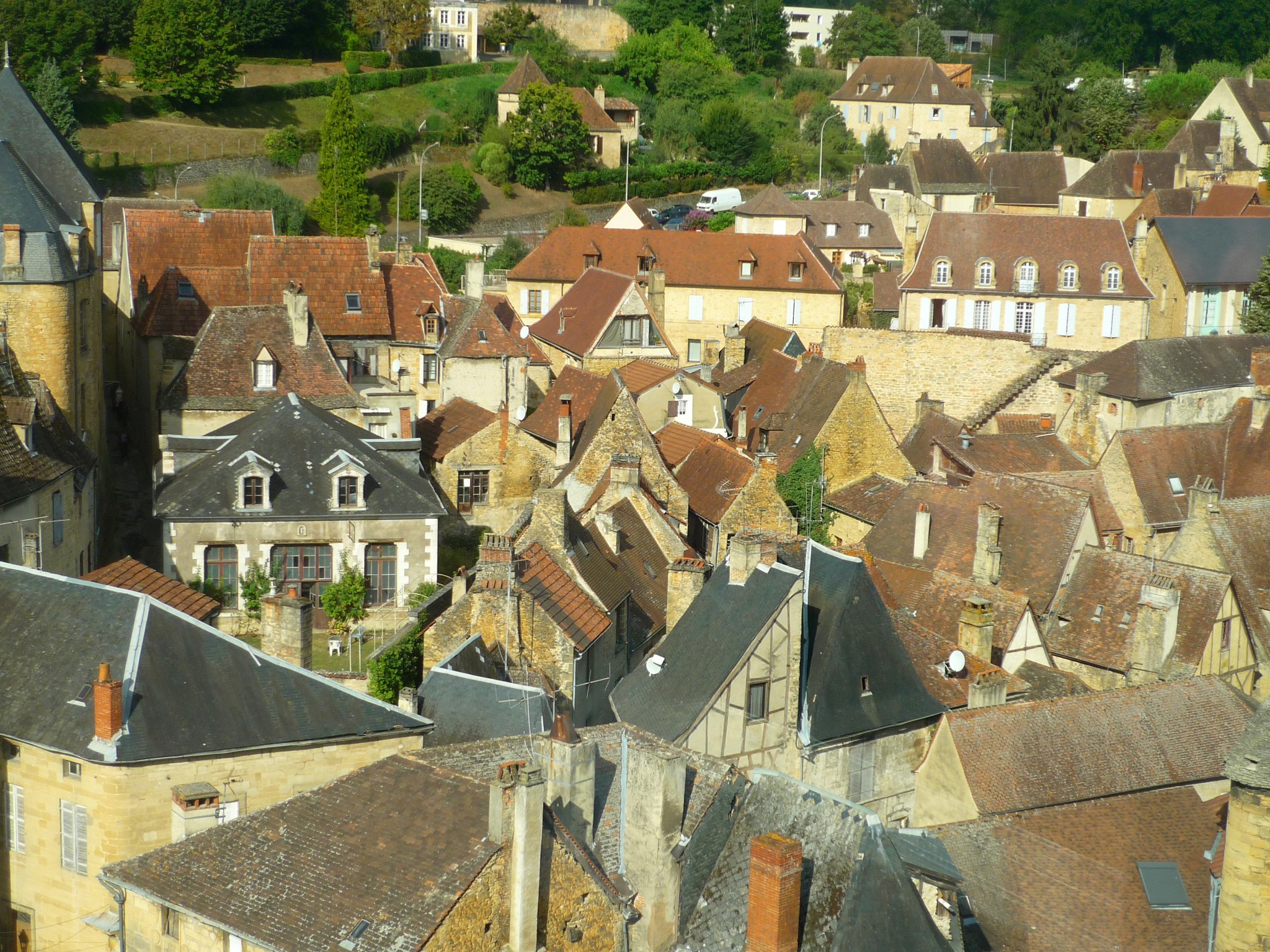
It would be impossible to miss the two monumental metallic doors. They each reach 17 metres high and weigh two tonnes.
Needless to say they were the cause of fierce controversy amongst the local population when the new covered market was inaugurated.
Rue des Consuls and its neighbourhood
The Plamon Mansion (Hôtel Plamon) on Rue des Consuls was built by a rich family of cloth manufacturers, the Selves de Plamon. The family became members of the local nobility through a marriage in 1483. Despite the juxtaposition of different architectural styles, the Plamon Mansion remained an architecturally harmonious edifice.
The ground floor and the first floor display remarkable stone filigrees: ribs from the 14th century, while the second floor is decorated with mullioned windows dating to the 15th century. The storeys are joined by a beautiful wooden staircase.
The porch and the staircase tower both date back to the 17th century. On the façade, notice the sculptures and the hooks upon which the inhabitants used to hang banners, tapestries and consular rings. Today, the Plamon Mansion plays hots to the Historical Museum of Sarlat and Périgord Noir.
On Rue des Consuls, opposite the Plamon Mansion can be found the little St. Mary Fountain, carved out in a natural cave in the 12th century.
Following a contamination of its water after six centuries of being used, the local authorities built up a wall to prevent the inhabitants to use it. It was only in 1970 that the fountain was again accessed to the public but its water is still not drinkable!
The charming and picturesque little square of Place du Marché des Trois Oies is famous for the sculpted geese of F.-X. Lalanne, symbols of the local gastronomic heritage.
The Chassaing Mansion or Gisson Mansion (Hôtel Chassaing or Magnanat) was built in the 15th century consists of two buildings, linked by a hexagonal staircase tower. One building displays a Gothic twin window with small columns and a Renaissance mullioned bay-window.
The Magnanat dynasty, who built the mansion, also resided at the Castle of Labro, near the charming village of La Roque-Gageac, as it was customary for the noble families of Sarlat to build a multitude of small castles in the region of Périgord Noir.
Next to the Chassaing Mansion on Place du Marché des Trois Oies, the 15th century Vassal Mansion (Hôtel Vassal) is arguably the most picturesque with its twin corbelled turrets.
Rue de la Salamandre and the Présidial
The Grézel Mansion (Hôtel Grézel), located on Rue de la Salamandre, was built towards the end of the 15th century and houses one of the oldest restaurants in Sarlat (“Gueule et Gosier”). A noble tower of flamboyant Gothic style with a beautifully-crafted doorway is located adjacent to the half-timbered façade.
The Présidial Building was the seat of the Royal Court, set up by Henri II in 1552. It features an unusual façade covered with Virginia creeper with a large central arch supporting a loggia, topped by a curious little polygonal lantern which lights the vast interior staircase.
The Western District (Quartier Ouest)
The Western District of Sarlat’s old town is separated from the touristy Eastern sector by the Rue de la République (or Traverse) and is still in the process of being restored. Although it does not contain as many mansions as the rich former ‘bourgeois, eastern part of Sarlat, this district is definitely worth a visit.
Wandering through Rue Jean-Jacques Rousseau and the adjacent winding and narrow cobbled lanes, you will discover a quieter area of town, with old houses, ornate doorways and relics of the medieval ramparts.
Dating back to 1580, the Tour du Bourreau (the Executioner’s Tower) is the only tower (with the exception of the Tour de la Bouquerie) which is still standing from amongst the 18 which made up the ramparts. It is now an art gallery and there is a fine panoramic view over Sarlat visible from its top.
At the end of Rue Rousset is the Tour de Guet (Watchtower): a 15th century crenulated tower, next to a corbelled turret.
The Chapel of the Pénitents Blancs was built between 1622 and 1626 and used to be part of the Récollets Convent. Look out for its refined baroque doorway.
Tourist information Centre of Sarlat-la-Canéda: http://www.sarlat-tourisme.com

